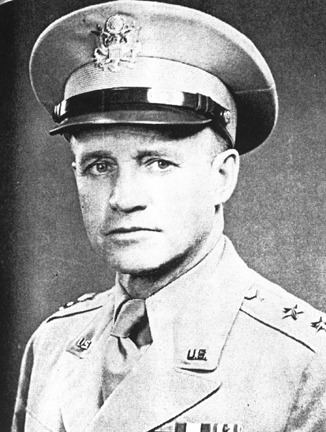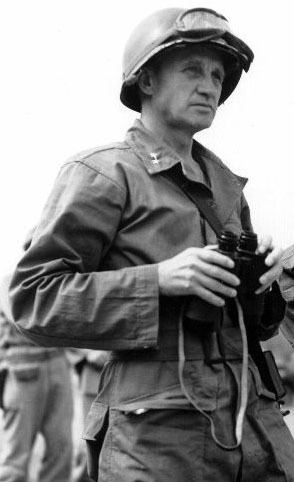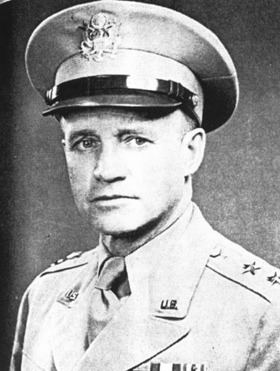Nickname(s) "Hap" | Name Hobart Gay Years of service 1917–1955 | |
 | ||
Born May 16, 1894Rockport, Illinois ( 1894-05-16 ) Allegiance United States of America Commands held U.S. Fifteenth ArmyU.S. 1st Armored DivisionMilitary District of Washington1st Cavalry Division (United States)U.S. VI CorpsU.S. III CorpsU.S. Fifth ArmyAnti-aircraft and Guided Missile Center Battles/wars World War IIKorean War Awards Distinguished Service Cross (2)Distinguished Service Medal (2)Legion of Merit (2)Silver Star (3)Bronze Star (2) Similar People Paik Sun‑yup, George S Patton, Peng Dehuai, Frank W Milburn, Omar Bradley | ||
Hobart Raymond Gay (May 16, 1894 – August 19, 1983), nicknamed Hap, was a United States Army lieutenant general.
Contents
- Early military career
- World War II
- Post World War II Europe
- Korean War
- Post Korean War
- Retirement
- Awards and decorations
- Media portrayal
- References

Early military career

He was first commissioned into the Army Reserve as a 2nd Lieutenant following his graduation from Knox College in 1917. On October 26, 1917, Gay was commissioned into the Regular Army. He was promoted to 1st Lieutenant on October 26, 1917 and Captain in July 1920. In his early career, he was a cavalry officer. He transferred to the Quartermaster Corps June 11, 1934 and was promoted to Major on August 1, 1935. He was promoted to Lieutenant Colonel on August 18, 1940 and colonel on December 24, 1941. As a Captain, he tutored author Robert A. Heinlein in equitation and musketry.
World War II
General Gay was awarded the Silver Star in December 1942 for gallantry in action on November 8, 1942 at Casablanca. He was chief of staff of the I Armored Corps, commanded by General George S. Patton, in North Africa at the time. Gay would continue to serve as Patton's chief of staff until Patton's death in December 1945.
Gay was promoted to brigadier general on June 24, 1943. In the Sicily campaign he was assigned to the U.S. Seventh Army as chief of staff. He became chief of staff, Third Army, in February 1944. In this capacity, Gay was a key member of Patton's command staff during the Third Army's drive into Germany following the Normandy invasion.
When Patton took command of the U.S. Fifteenth Army in October 1945, Gay was again his chief of staff. He and Patton went pheasant hunting on December 9, 1945. Patton and Gay were seated in the back seat of the staff car, en route to the hunting lodge. There was a traffic accident, during which Patton sustained spinal injuries which later cost him his life. General Gay was uninjured.
Post World War II Europe
After Patton's death, Gay assumed command of Fifteenth Army in January 1946 for a period of one month. He then became commander of the U.S. 1st Armored Division until its return to the United States later in 1946. He then assumed command of the Second Constabulary Brigade. He served in Europe until 1947, when he returned to the United States.
Gay returned to the United States and commanded the Military District of Washington until September 1949. During his command of the district, General John J. Pershing died at Walter Reed Army Medical Center on 15 July 1948. In accordance with tradition, Gen. Gay coordinated arrangements for Pershing's funeral ceremonies as the representative of the U.S. President.
Korean War
In September 1949, Gay took command of the 1st Cavalry Division in Osaka, Japan. He brought the 1st Cavalry to Korea, where it was in action on July 19, 1950, joining in the general South Korean-U.S. retreat before the North Korean invasion force.
Over three days in late July, the division's 7th Cavalry Regiment and U.S. warplanes killed a large number of South Korean refugees at No Gun Ri, an event first confirmed by The Associated Press in 1999 and later acknowledged in a U.S. Army investigation. The South Korean government in 2005 certified the names of 163 No Gun Ri dead and missing and 55 wounded, and said many more likely were killed. On July 26, the day the No Gun Ri killings began, Gay told rear-echelon reporters he was sure most refugees fleeing south were North Korean infiltrators. Two days earlier, word had been sent from his operations staff to fire on all refugees trying to cross U.S. lines. Gay himself later described refugees as "fair game," and the U.S. ambassador in South Korea said such a policy had been adopted theater-wide. On August 4, 1950, after U.S. forces withdrew across the Naktong River, Gay ordered the blowing of the Waegwan bridge, killing hundreds of refugees trying to cross.
His 1st Cavalry Division then played a crucial, costly role in the successful last-ditch defense of the Pusan Perimeter, and joined in the breakout of U.S. and South Korean units headed north in September in conjunction with the landing of U.S. forces at Inchon. Gay's troops then led the strike across the 38th Parallel and into Pyongyang, capturing the North Korean capital on October 19–20. Two weeks later, his 8th Cavalry Regiment was hit hard by newly arriving Chinese Communist forces at Unsan, north of Pyongyang, with one battalion left trapped when Gay's rescue efforts were ordered halted by his superior, I Corps commander Maj. Gen. Frank W. Milburn. The Chinese drove the 1st Cavalry Division and other U.S. forces from North Korea in December, and in early 1951 Gay, along with other top officers in Korea, was relieved of his command.
Gay was appointed deputy commander of the U.S. Fourth Army in February, 1951. In July 1952 he was appointed commander of U.S. VI Corps at Camp Atterbury, Indiana and in April, 1953 made commanding general of U.S. III Corps at Fort MacArthur, California. He moved to Fort Hood in Texas when the III Corps was reassigned there.
Post Korean War
In September 1954 General Gay was made commander of U.S. Fifth Army in Chicago, Illinois. He was nominated by President Dwight D. Eisenhower in October 1954 for promotion to Lieutenant General (temporary).
Hobart R. Gay's career in the U.S. Army ended in 1955 as the Commanding General, Anti-aircraft and Guided Missile Center, Fort Bliss, Texas.
Retirement
Following retirement, Gay became superintendent of the New Mexico Military Institute.
He died in El Paso, Texas and was interred at the Fort Bliss National Cemetery.
